MITS5003 Wireless Networks: WSN Implementation at MaffraStock
VerifiedAdded on 2023/06/11
|7
|1357
|159
Case Study
AI Summary
This document presents a solution to a case study involving the implementation of a Wireless Sensor Network (WSN) for VicStock's MaffraStock farm. The solution addresses key aspects of WSN design, including the selection of a suitable frequency band (5.0 GHz divided into 2500 channels with 2 M...
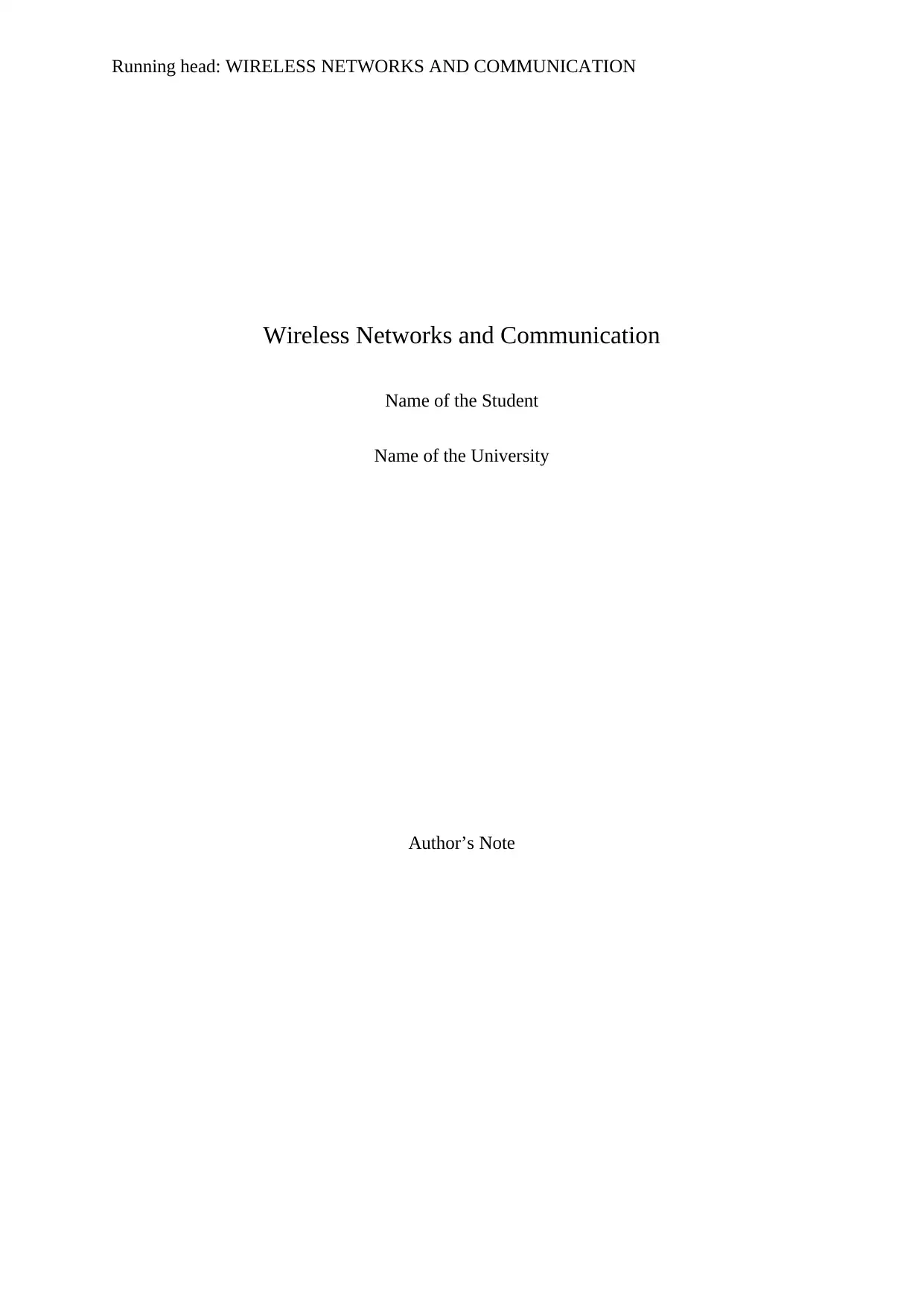
Running head: WIRELESS NETWORKS AND COMMUNICATION
Wireless Networks and Communication
Name of the Student
Name of the University
Author’s Note
Wireless Networks and Communication
Name of the Student
Name of the University
Author’s Note
Paraphrase This Document
Need a fresh take? Get an instant paraphrase of this document with our AI Paraphraser
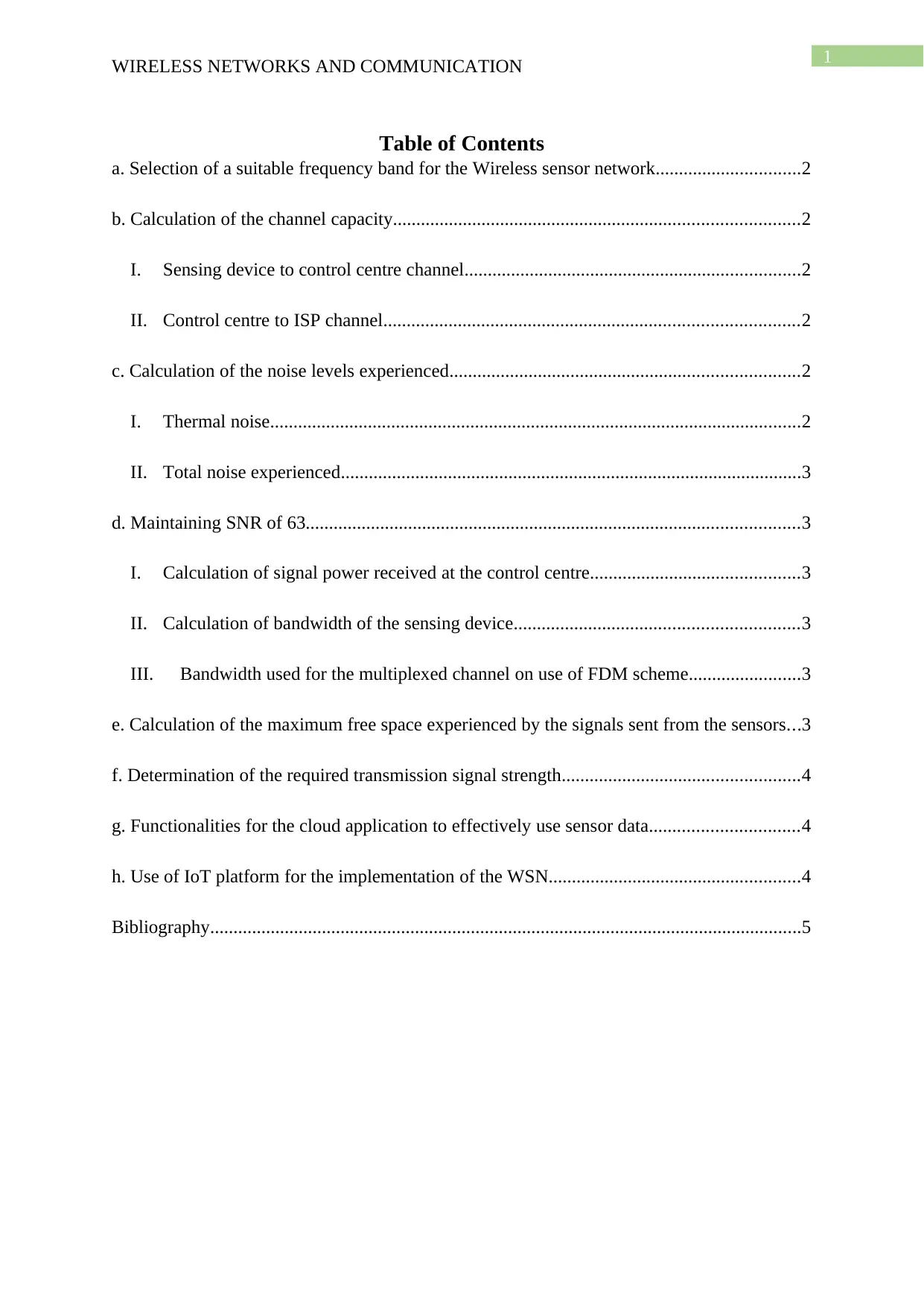
1
WIRELESS NETWORKS AND COMMUNICATION
Table of Contents
a. Selection of a suitable frequency band for the Wireless sensor network...............................2
b. Calculation of the channel capacity.......................................................................................2
I. Sensing device to control centre channel........................................................................2
II. Control centre to ISP channel.........................................................................................2
c. Calculation of the noise levels experienced...........................................................................2
I. Thermal noise..................................................................................................................2
II. Total noise experienced...................................................................................................3
d. Maintaining SNR of 63..........................................................................................................3
I. Calculation of signal power received at the control centre.............................................3
II. Calculation of bandwidth of the sensing device.............................................................3
III. Bandwidth used for the multiplexed channel on use of FDM scheme........................3
e. Calculation of the maximum free space experienced by the signals sent from the sensors...3
f. Determination of the required transmission signal strength...................................................4
g. Functionalities for the cloud application to effectively use sensor data................................4
h. Use of IoT platform for the implementation of the WSN......................................................4
Bibliography...............................................................................................................................5
WIRELESS NETWORKS AND COMMUNICATION
Table of Contents
a. Selection of a suitable frequency band for the Wireless sensor network...............................2
b. Calculation of the channel capacity.......................................................................................2
I. Sensing device to control centre channel........................................................................2
II. Control centre to ISP channel.........................................................................................2
c. Calculation of the noise levels experienced...........................................................................2
I. Thermal noise..................................................................................................................2
II. Total noise experienced...................................................................................................3
d. Maintaining SNR of 63..........................................................................................................3
I. Calculation of signal power received at the control centre.............................................3
II. Calculation of bandwidth of the sensing device.............................................................3
III. Bandwidth used for the multiplexed channel on use of FDM scheme........................3
e. Calculation of the maximum free space experienced by the signals sent from the sensors...3
f. Determination of the required transmission signal strength...................................................4
g. Functionalities for the cloud application to effectively use sensor data................................4
h. Use of IoT platform for the implementation of the WSN......................................................4
Bibliography...............................................................................................................................5
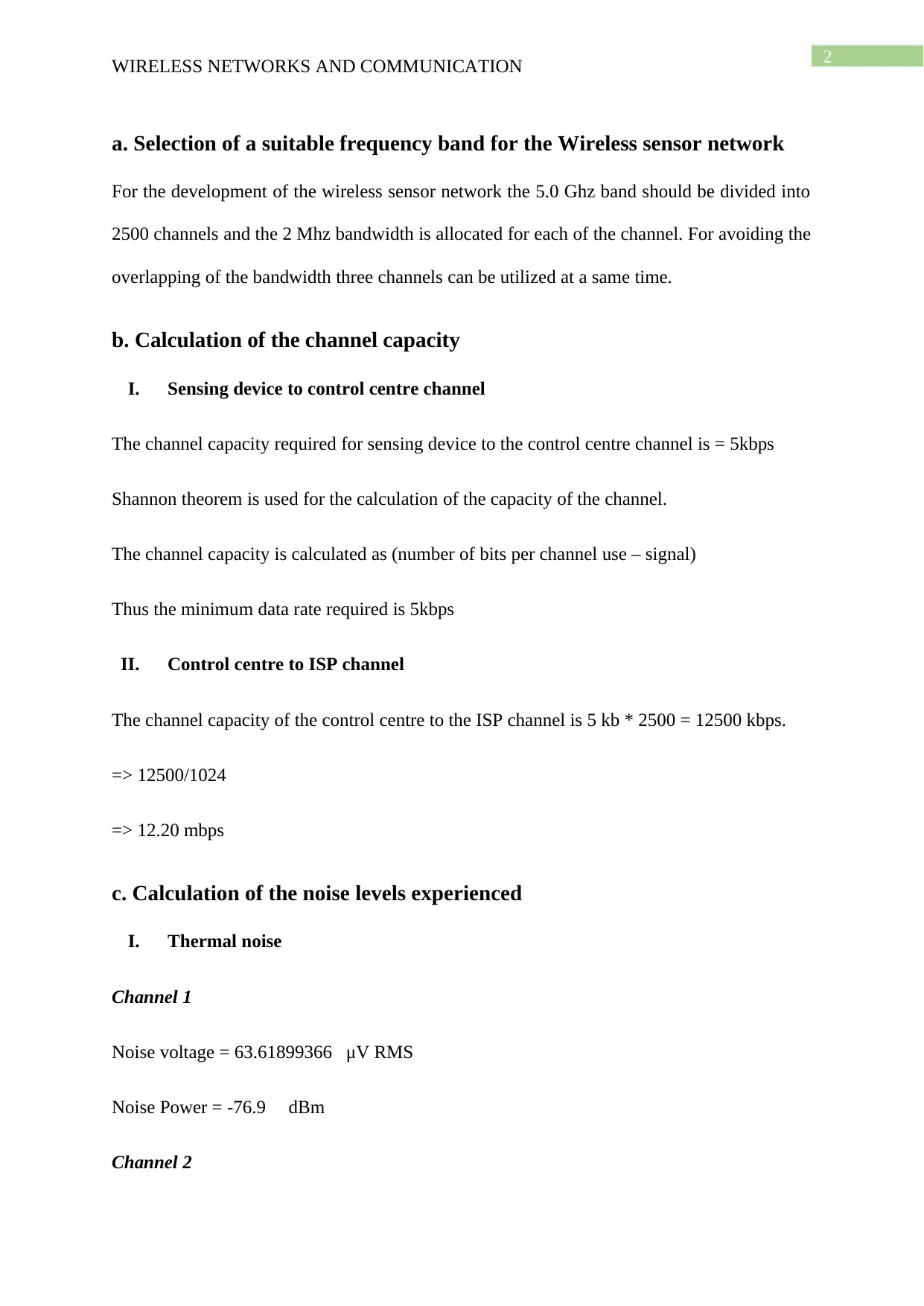
2
WIRELESS NETWORKS AND COMMUNICATION
a. Selection of a suitable frequency band for the Wireless sensor network
For the development of the wireless sensor network the 5.0 Ghz band should be divided into
2500 channels and the 2 Mhz bandwidth is allocated for each of the channel. For avoiding the
overlapping of the bandwidth three channels can be utilized at a same time.
b. Calculation of the channel capacity
I. Sensing device to control centre channel
The channel capacity required for sensing device to the control centre channel is = 5kbps
Shannon theorem is used for the calculation of the capacity of the channel.
The channel capacity is calculated as (number of bits per channel use – signal)
Thus the minimum data rate required is 5kbps
II. Control centre to ISP channel
The channel capacity of the control centre to the ISP channel is 5 kb * 2500 = 12500 kbps.
=> 12500/1024
=> 12.20 mbps
c. Calculation of the noise levels experienced
I. Thermal noise
Channel 1
Noise voltage = 63.61899366 μV RMS
Noise Power = -76.9 dBm
Channel 2
WIRELESS NETWORKS AND COMMUNICATION
a. Selection of a suitable frequency band for the Wireless sensor network
For the development of the wireless sensor network the 5.0 Ghz band should be divided into
2500 channels and the 2 Mhz bandwidth is allocated for each of the channel. For avoiding the
overlapping of the bandwidth three channels can be utilized at a same time.
b. Calculation of the channel capacity
I. Sensing device to control centre channel
The channel capacity required for sensing device to the control centre channel is = 5kbps
Shannon theorem is used for the calculation of the capacity of the channel.
The channel capacity is calculated as (number of bits per channel use – signal)
Thus the minimum data rate required is 5kbps
II. Control centre to ISP channel
The channel capacity of the control centre to the ISP channel is 5 kb * 2500 = 12500 kbps.
=> 12500/1024
=> 12.20 mbps
c. Calculation of the noise levels experienced
I. Thermal noise
Channel 1
Noise voltage = 63.61899366 μV RMS
Noise Power = -76.9 dBm
Channel 2
⊘ This is a preview!⊘
Do you want full access?
Subscribe today to unlock all pages.

Trusted by 1+ million students worldwide
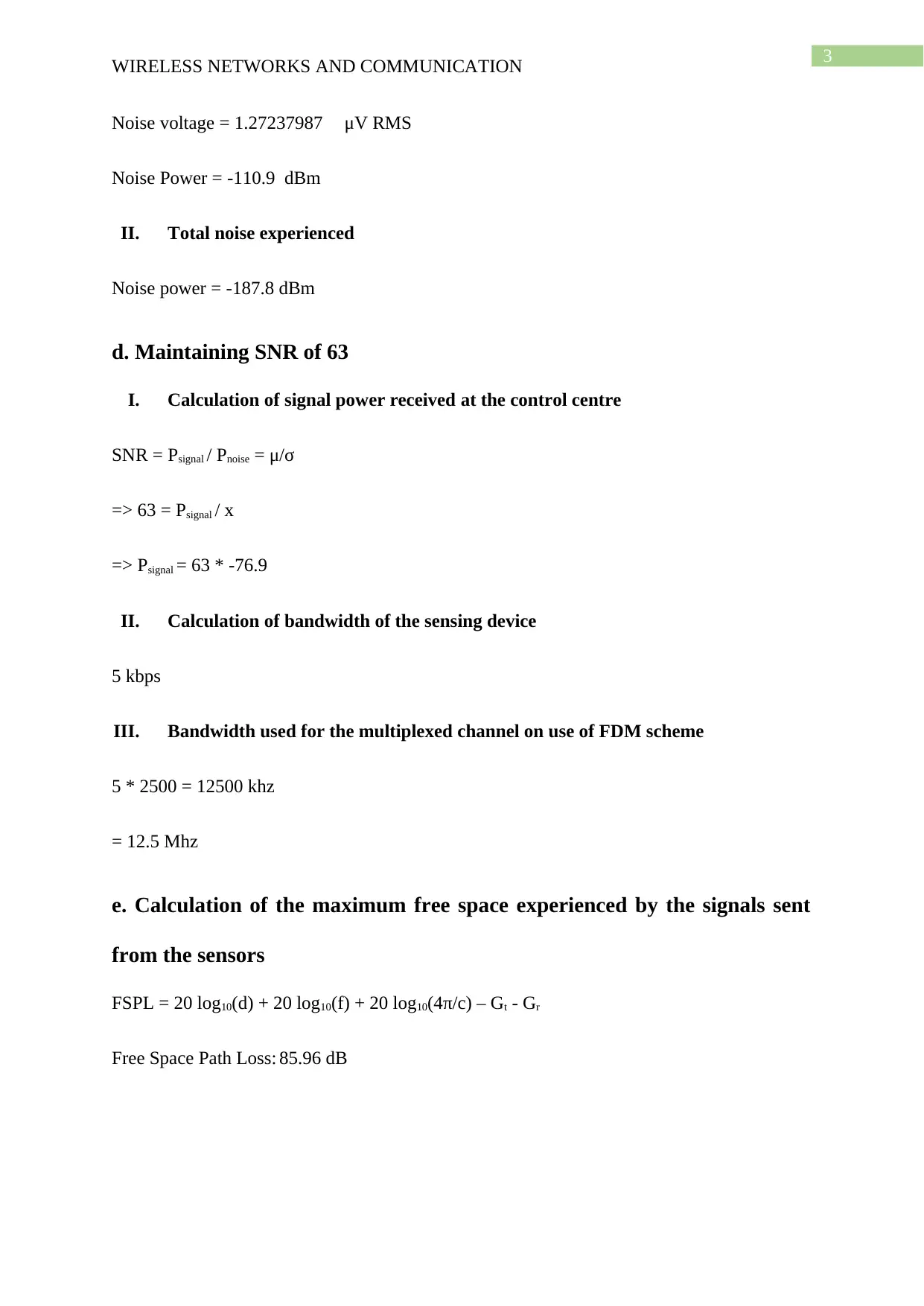
3
WIRELESS NETWORKS AND COMMUNICATION
Noise voltage = 1.27237987 μV RMS
Noise Power = -110.9 dBm
II. Total noise experienced
Noise power = -187.8 dBm
d. Maintaining SNR of 63
I. Calculation of signal power received at the control centre
SNR = Psignal / Pnoise = μ/σ
=> 63 = Psignal / x
=> Psignal = 63 * -76.9
II. Calculation of bandwidth of the sensing device
5 kbps
III. Bandwidth used for the multiplexed channel on use of FDM scheme
5 * 2500 = 12500 khz
= 12.5 Mhz
e. Calculation of the maximum free space experienced by the signals sent
from the sensors
FSPL = 20 log10(d) + 20 log10(f) + 20 log10(4π/c) – Gt - Gr
Free Space Path Loss: 85.96 dB
WIRELESS NETWORKS AND COMMUNICATION
Noise voltage = 1.27237987 μV RMS
Noise Power = -110.9 dBm
II. Total noise experienced
Noise power = -187.8 dBm
d. Maintaining SNR of 63
I. Calculation of signal power received at the control centre
SNR = Psignal / Pnoise = μ/σ
=> 63 = Psignal / x
=> Psignal = 63 * -76.9
II. Calculation of bandwidth of the sensing device
5 kbps
III. Bandwidth used for the multiplexed channel on use of FDM scheme
5 * 2500 = 12500 khz
= 12.5 Mhz
e. Calculation of the maximum free space experienced by the signals sent
from the sensors
FSPL = 20 log10(d) + 20 log10(f) + 20 log10(4π/c) – Gt - Gr
Free Space Path Loss: 85.96 dB
Paraphrase This Document
Need a fresh take? Get an instant paraphrase of this document with our AI Paraphraser
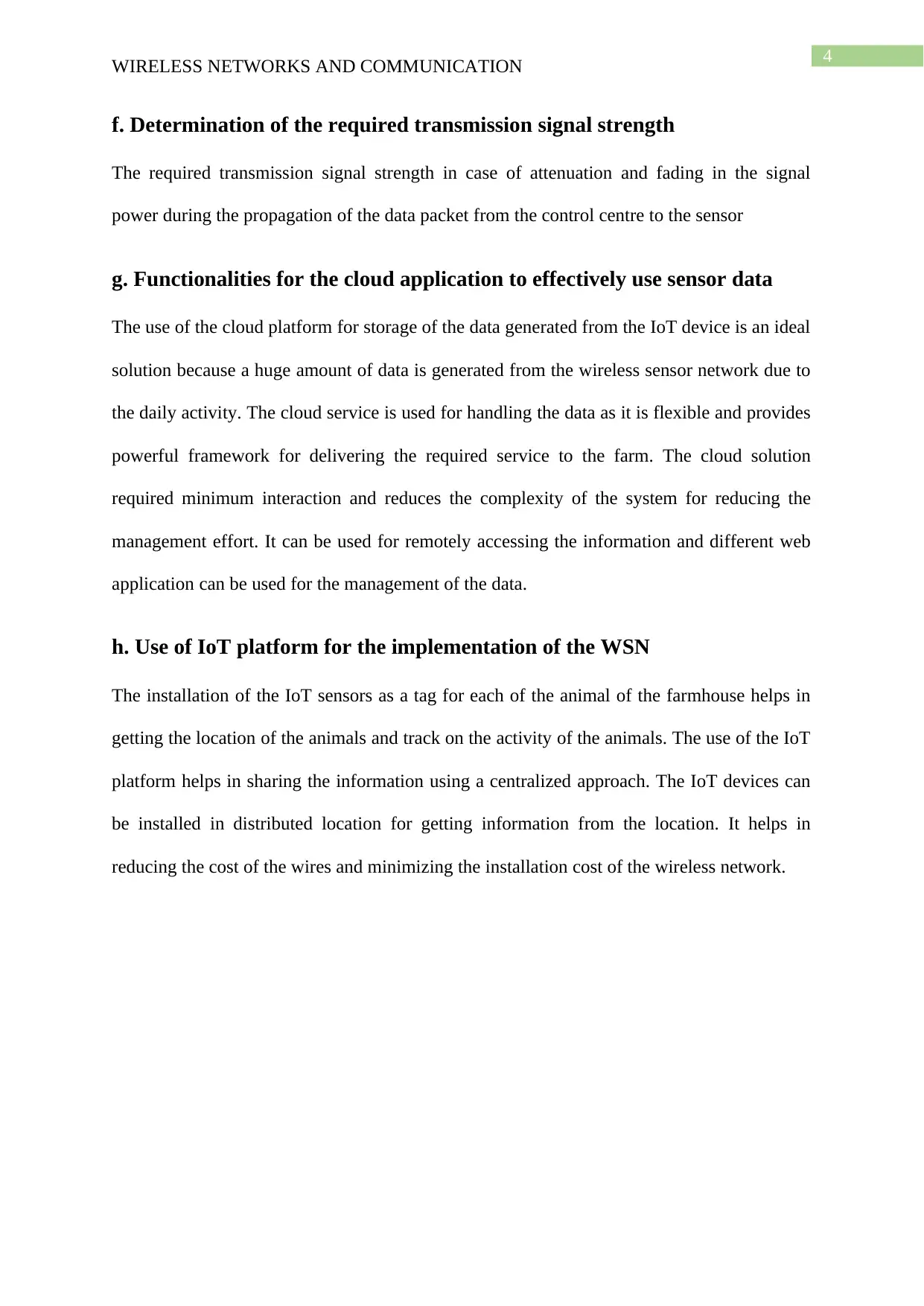
4
WIRELESS NETWORKS AND COMMUNICATION
f. Determination of the required transmission signal strength
The required transmission signal strength in case of attenuation and fading in the signal
power during the propagation of the data packet from the control centre to the sensor
g. Functionalities for the cloud application to effectively use sensor data
The use of the cloud platform for storage of the data generated from the IoT device is an ideal
solution because a huge amount of data is generated from the wireless sensor network due to
the daily activity. The cloud service is used for handling the data as it is flexible and provides
powerful framework for delivering the required service to the farm. The cloud solution
required minimum interaction and reduces the complexity of the system for reducing the
management effort. It can be used for remotely accessing the information and different web
application can be used for the management of the data.
h. Use of IoT platform for the implementation of the WSN
The installation of the IoT sensors as a tag for each of the animal of the farmhouse helps in
getting the location of the animals and track on the activity of the animals. The use of the IoT
platform helps in sharing the information using a centralized approach. The IoT devices can
be installed in distributed location for getting information from the location. It helps in
reducing the cost of the wires and minimizing the installation cost of the wireless network.
WIRELESS NETWORKS AND COMMUNICATION
f. Determination of the required transmission signal strength
The required transmission signal strength in case of attenuation and fading in the signal
power during the propagation of the data packet from the control centre to the sensor
g. Functionalities for the cloud application to effectively use sensor data
The use of the cloud platform for storage of the data generated from the IoT device is an ideal
solution because a huge amount of data is generated from the wireless sensor network due to
the daily activity. The cloud service is used for handling the data as it is flexible and provides
powerful framework for delivering the required service to the farm. The cloud solution
required minimum interaction and reduces the complexity of the system for reducing the
management effort. It can be used for remotely accessing the information and different web
application can be used for the management of the data.
h. Use of IoT platform for the implementation of the WSN
The installation of the IoT sensors as a tag for each of the animal of the farmhouse helps in
getting the location of the animals and track on the activity of the animals. The use of the IoT
platform helps in sharing the information using a centralized approach. The IoT devices can
be installed in distributed location for getting information from the location. It helps in
reducing the cost of the wires and minimizing the installation cost of the wireless network.
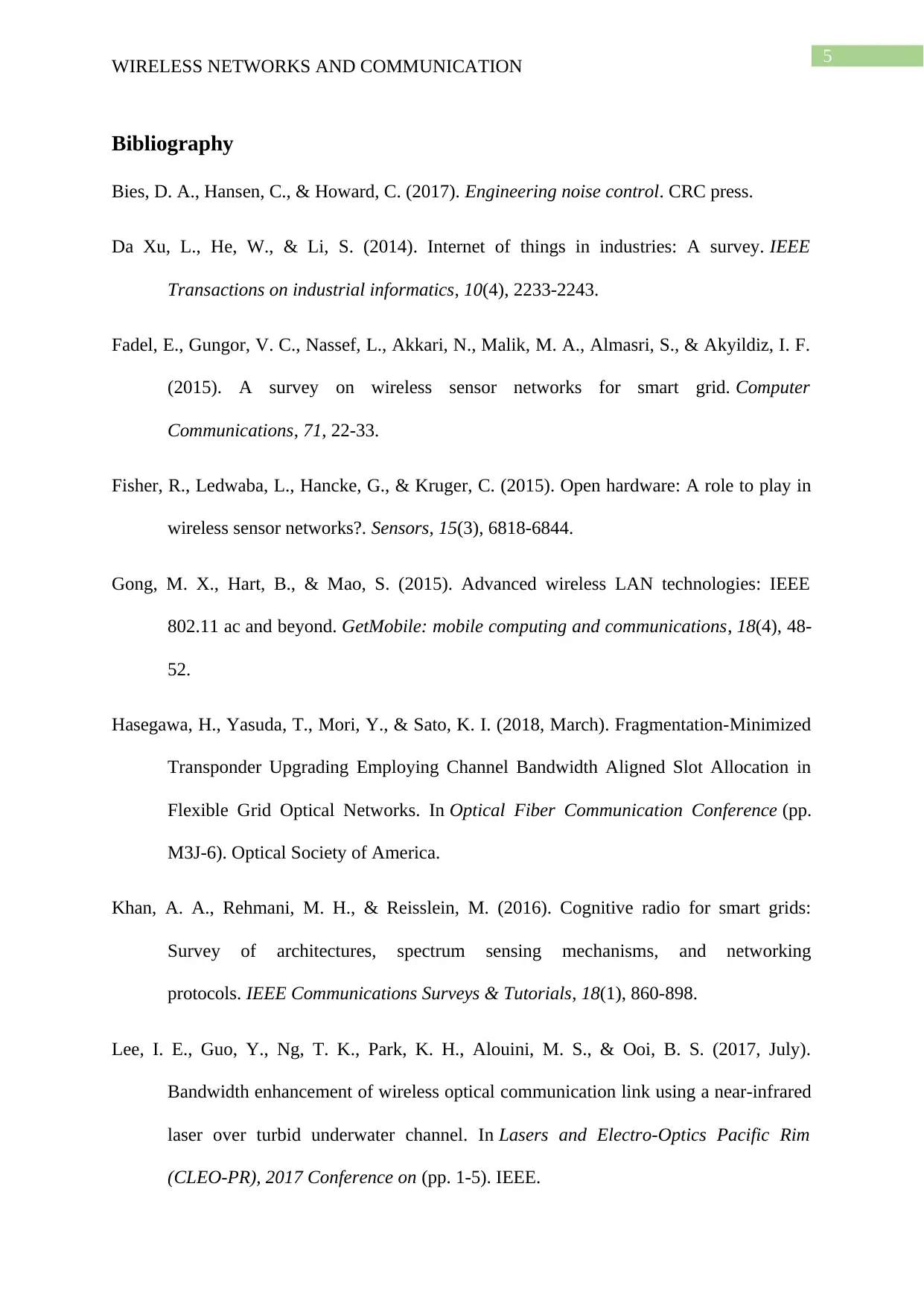
5
WIRELESS NETWORKS AND COMMUNICATION
Bibliography
Bies, D. A., Hansen, C., & Howard, C. (2017). Engineering noise control. CRC press.
Da Xu, L., He, W., & Li, S. (2014). Internet of things in industries: A survey. IEEE
Transactions on industrial informatics, 10(4), 2233-2243.
Fadel, E., Gungor, V. C., Nassef, L., Akkari, N., Malik, M. A., Almasri, S., & Akyildiz, I. F.
(2015). A survey on wireless sensor networks for smart grid. Computer
Communications, 71, 22-33.
Fisher, R., Ledwaba, L., Hancke, G., & Kruger, C. (2015). Open hardware: A role to play in
wireless sensor networks?. Sensors, 15(3), 6818-6844.
Gong, M. X., Hart, B., & Mao, S. (2015). Advanced wireless LAN technologies: IEEE
802.11 ac and beyond. GetMobile: mobile computing and communications, 18(4), 48-
52.
Hasegawa, H., Yasuda, T., Mori, Y., & Sato, K. I. (2018, March). Fragmentation-Minimized
Transponder Upgrading Employing Channel Bandwidth Aligned Slot Allocation in
Flexible Grid Optical Networks. In Optical Fiber Communication Conference (pp.
M3J-6). Optical Society of America.
Khan, A. A., Rehmani, M. H., & Reisslein, M. (2016). Cognitive radio for smart grids:
Survey of architectures, spectrum sensing mechanisms, and networking
protocols. IEEE Communications Surveys & Tutorials, 18(1), 860-898.
Lee, I. E., Guo, Y., Ng, T. K., Park, K. H., Alouini, M. S., & Ooi, B. S. (2017, July).
Bandwidth enhancement of wireless optical communication link using a near-infrared
laser over turbid underwater channel. In Lasers and Electro-Optics Pacific Rim
(CLEO-PR), 2017 Conference on (pp. 1-5). IEEE.
WIRELESS NETWORKS AND COMMUNICATION
Bibliography
Bies, D. A., Hansen, C., & Howard, C. (2017). Engineering noise control. CRC press.
Da Xu, L., He, W., & Li, S. (2014). Internet of things in industries: A survey. IEEE
Transactions on industrial informatics, 10(4), 2233-2243.
Fadel, E., Gungor, V. C., Nassef, L., Akkari, N., Malik, M. A., Almasri, S., & Akyildiz, I. F.
(2015). A survey on wireless sensor networks for smart grid. Computer
Communications, 71, 22-33.
Fisher, R., Ledwaba, L., Hancke, G., & Kruger, C. (2015). Open hardware: A role to play in
wireless sensor networks?. Sensors, 15(3), 6818-6844.
Gong, M. X., Hart, B., & Mao, S. (2015). Advanced wireless LAN technologies: IEEE
802.11 ac and beyond. GetMobile: mobile computing and communications, 18(4), 48-
52.
Hasegawa, H., Yasuda, T., Mori, Y., & Sato, K. I. (2018, March). Fragmentation-Minimized
Transponder Upgrading Employing Channel Bandwidth Aligned Slot Allocation in
Flexible Grid Optical Networks. In Optical Fiber Communication Conference (pp.
M3J-6). Optical Society of America.
Khan, A. A., Rehmani, M. H., & Reisslein, M. (2016). Cognitive radio for smart grids:
Survey of architectures, spectrum sensing mechanisms, and networking
protocols. IEEE Communications Surveys & Tutorials, 18(1), 860-898.
Lee, I. E., Guo, Y., Ng, T. K., Park, K. H., Alouini, M. S., & Ooi, B. S. (2017, July).
Bandwidth enhancement of wireless optical communication link using a near-infrared
laser over turbid underwater channel. In Lasers and Electro-Optics Pacific Rim
(CLEO-PR), 2017 Conference on (pp. 1-5). IEEE.
⊘ This is a preview!⊘
Do you want full access?
Subscribe today to unlock all pages.

Trusted by 1+ million students worldwide
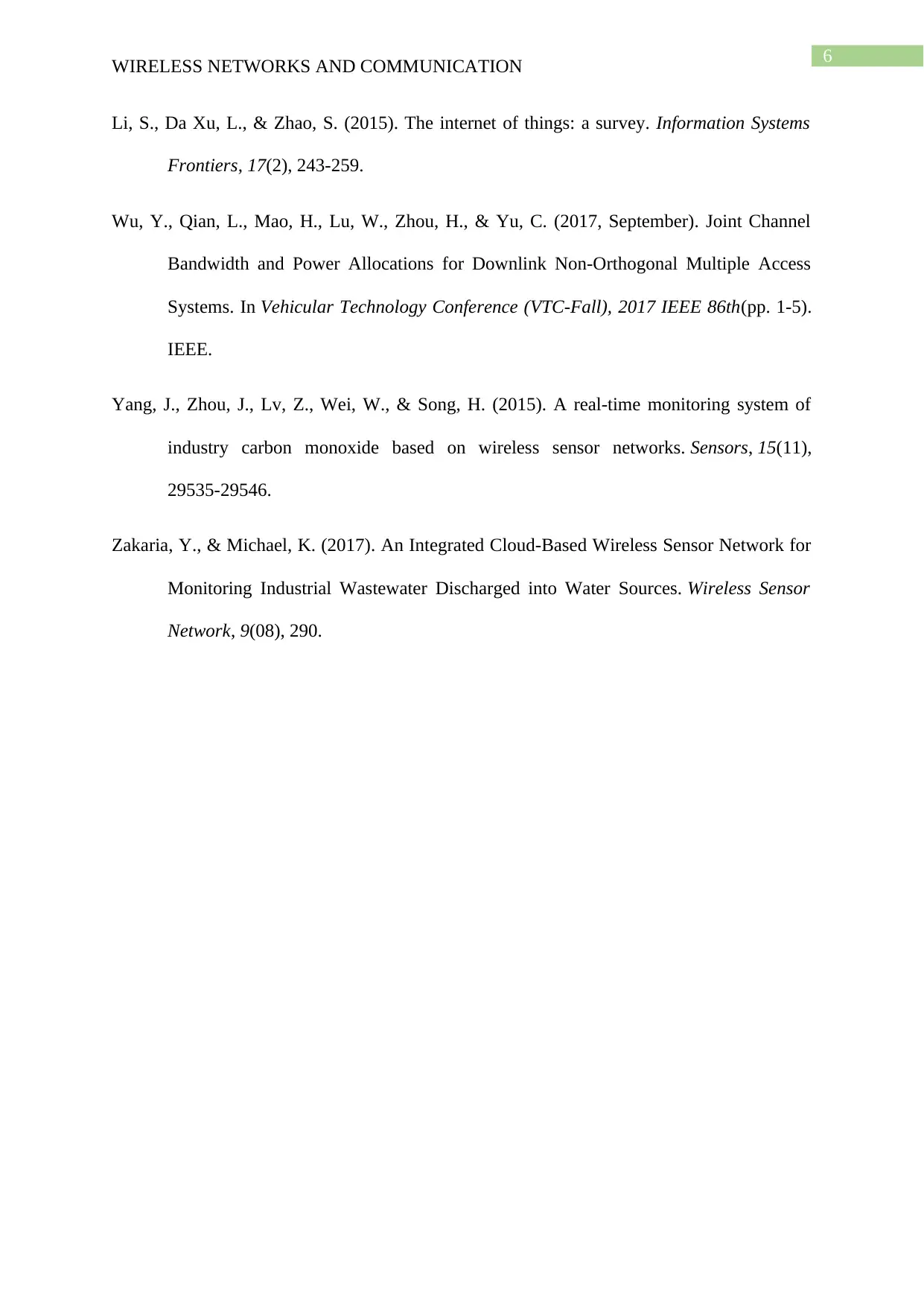
6
WIRELESS NETWORKS AND COMMUNICATION
Li, S., Da Xu, L., & Zhao, S. (2015). The internet of things: a survey. Information Systems
Frontiers, 17(2), 243-259.
Wu, Y., Qian, L., Mao, H., Lu, W., Zhou, H., & Yu, C. (2017, September). Joint Channel
Bandwidth and Power Allocations for Downlink Non-Orthogonal Multiple Access
Systems. In Vehicular Technology Conference (VTC-Fall), 2017 IEEE 86th(pp. 1-5).
IEEE.
Yang, J., Zhou, J., Lv, Z., Wei, W., & Song, H. (2015). A real-time monitoring system of
industry carbon monoxide based on wireless sensor networks. Sensors, 15(11),
29535-29546.
Zakaria, Y., & Michael, K. (2017). An Integrated Cloud-Based Wireless Sensor Network for
Monitoring Industrial Wastewater Discharged into Water Sources. Wireless Sensor
Network, 9(08), 290.
WIRELESS NETWORKS AND COMMUNICATION
Li, S., Da Xu, L., & Zhao, S. (2015). The internet of things: a survey. Information Systems
Frontiers, 17(2), 243-259.
Wu, Y., Qian, L., Mao, H., Lu, W., Zhou, H., & Yu, C. (2017, September). Joint Channel
Bandwidth and Power Allocations for Downlink Non-Orthogonal Multiple Access
Systems. In Vehicular Technology Conference (VTC-Fall), 2017 IEEE 86th(pp. 1-5).
IEEE.
Yang, J., Zhou, J., Lv, Z., Wei, W., & Song, H. (2015). A real-time monitoring system of
industry carbon monoxide based on wireless sensor networks. Sensors, 15(11),
29535-29546.
Zakaria, Y., & Michael, K. (2017). An Integrated Cloud-Based Wireless Sensor Network for
Monitoring Industrial Wastewater Discharged into Water Sources. Wireless Sensor
Network, 9(08), 290.
1 out of 7
Related Documents
Your All-in-One AI-Powered Toolkit for Academic Success.
+13062052269
info@desklib.com
Available 24*7 on WhatsApp / Email
![[object Object]](/_next/static/media/star-bottom.7253800d.svg)
Unlock your academic potential
© 2024 | Zucol Services PVT LTD | All rights reserved.


